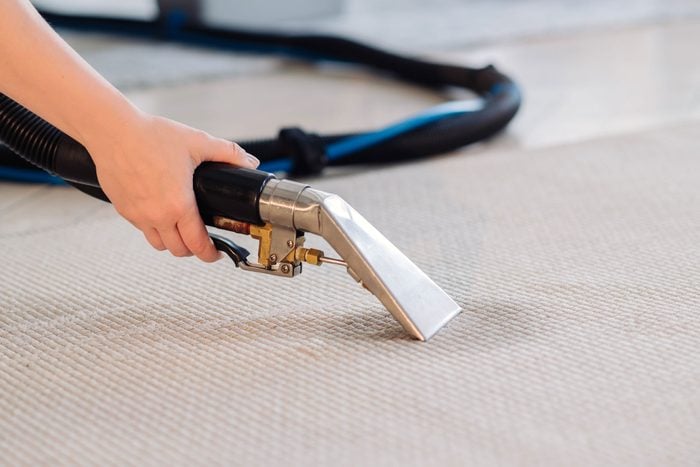What Should You Do If Your Basement Carpet Gets Wet?
Updated: May 03, 2024

A wet carpet in a flooded basement may be salvageable, depending on the water source, but you have to work fast before mold starts growing. Here's what you need to know to dry out wet carpet.
To decide what to do if your basement is flooded, go by these rules: If the floodwater was clean (think broken pipes, a burst washing machine supply hose or a foundation leak), you can probably dry out and save the carpet, but you’ve got to act fast. If the carpet isn’t dry within 72 hours, it’ll start to grow mold.
However, if the floodwater is dirty (we’re talking a sewer backup or washing machine drain water), you need to call in the pros.
For this scenario, we’ll assume the basement was flooded with clean water, the water is now shut off and the carpet cost is less than your insurance deductible (or you simply want to do it yourself to avoid a claim).
Turn Off Power
Before you set one boot on that squishy carpet, turn off the power to the basement. If you’re unsure which breakers power the basement receptacles, flip the main circuit breaker in the garage panel. If your electrical panel is in the basement, call an electrician to turn off the power.
Next, remove any extension cords and power strips from the floor and unplug or switch off all electrical appliances (washer, dryer, HVAC). Ask the electrician (if you hired one) to repower the upstairs (to keep the fridge going) and inspect the basement receptacles to determine whether it’s safe to repower them. If not, you must buy several GFCI-equipped extension cords and run power from upstairs receptacles.
Getting Water Out Of Your Basement
Once the risk of electrical shock has been eliminated, it’s time to extract the water from the carpet. Don’t waste your time trying to dry out the carpet with a wet/dry shop vacuum—it simply doesn’t have enough power. Instead, rent an extractor (if available) or carpet cleaner, an air mover fan or two and a large commercial dehumidifier. Rent the largest dehumidifier available. The big ones can remove up to 30 gallons per day, compared with 4 gallons for the largest home units.
Tips for Using a Water Extractor
Extraction is 1,200 times more effective than dehumidification. You’ll want to move the extractor slowly across the carpet to suck up as much water as possible. Don’t rush this step!
Removing Water-Logged Carpet
Once the water is out, peel back the carpeting (watch out for those rusted sharp nails on the tackless stripping) and remove the wet pad. Cut the pad into strips, roll it up and haul it outside. If the weather is hot, dry and sunny, you can try drying it yourself by rolling it out on your driveway. If that works, you can reinstall it by taping it back together. Just be aware that a new carpet pad is cheap, so don’t waste a lot of time trying to dry the old stuff.
Lay the carpet back on the floor and fire up the air movers and rental dehumidifier. Keep the basement temperature at or below 75 degrees F. You might think hotter is better because it will dry out everything faster. But a higher temp will accelerate bacterial growth and turn your basement into a petri dish.
While the carpet is drying, check the condition of the wall insulation. If you don’t have insulation and you dry out the basement quickly, you don’t have to replace the drywall. But if the insulation is wet, it has to go (wet insulation cannot be saved). Snap a chalk line, cut the drywall with a recip saw and toss the wet stuff. Replace the insulation and install new drywall.
When To Call a Pro
If you had a sewer backup, washing machine drain water spill or river flood, you need professional help. Pros are the only ones with the proper equipment to dry and disinfect your basement in the shortest possible time.
To find a certified water restoration professional, search online for “Water Damage Restoration.” Look for IICRC (Institute of Inspection, Cleaning and Restoration Certification) credentials in the company information (Servicemaster is one company that is fully certified). Or, go to iicrc.org and click on “Locate a Pro.”
Be aware that pros can give you a rough price estimate (the average cost of a basement cleanup is $2,500), but the final cost depends on how long it takes them to dry out your basement. There are just too many variables beyond their control (inside and outside temperature and humidity levels) to give you a set price upfront. Be wary of any company that gives you a set price over the phone.
